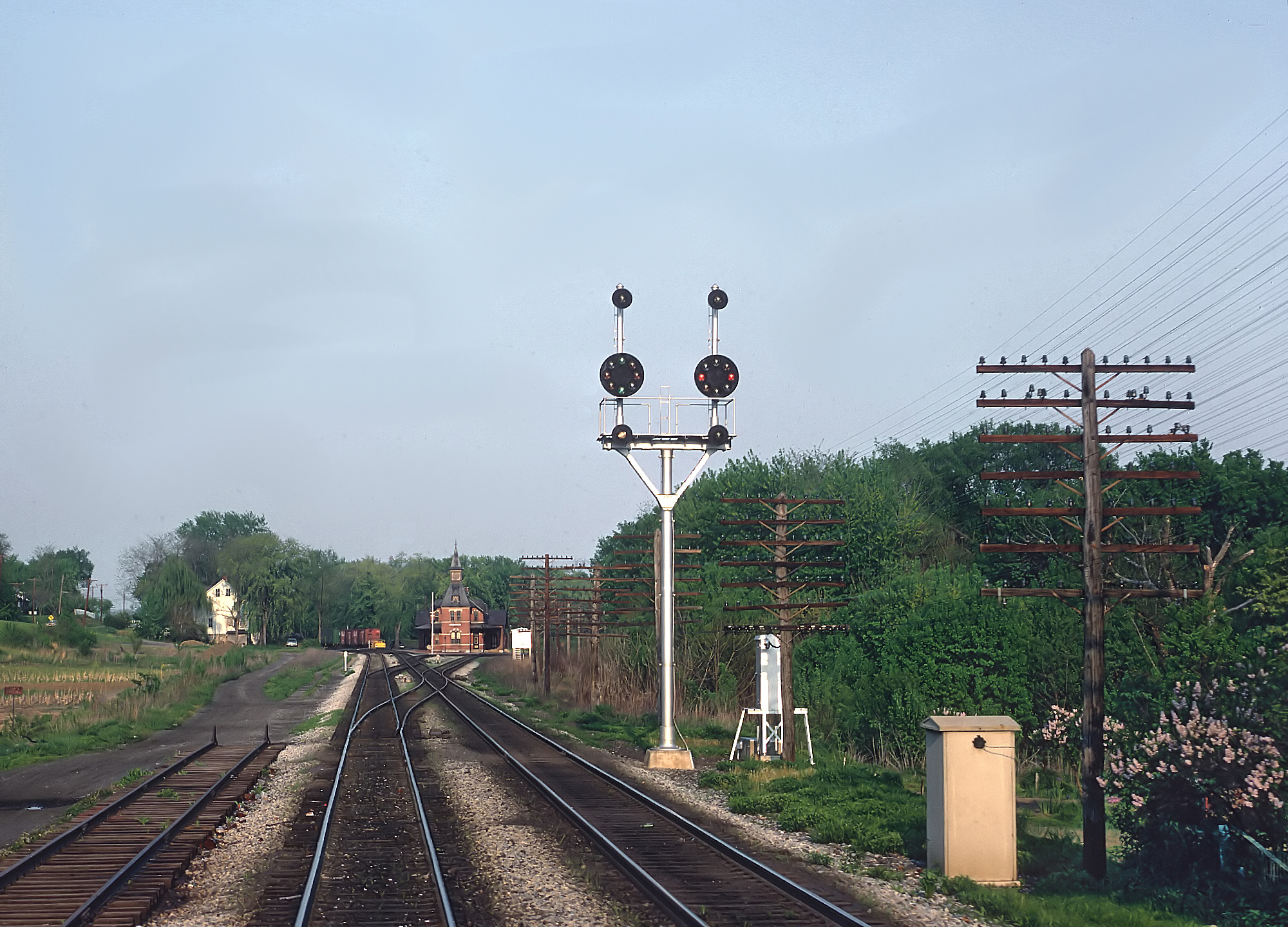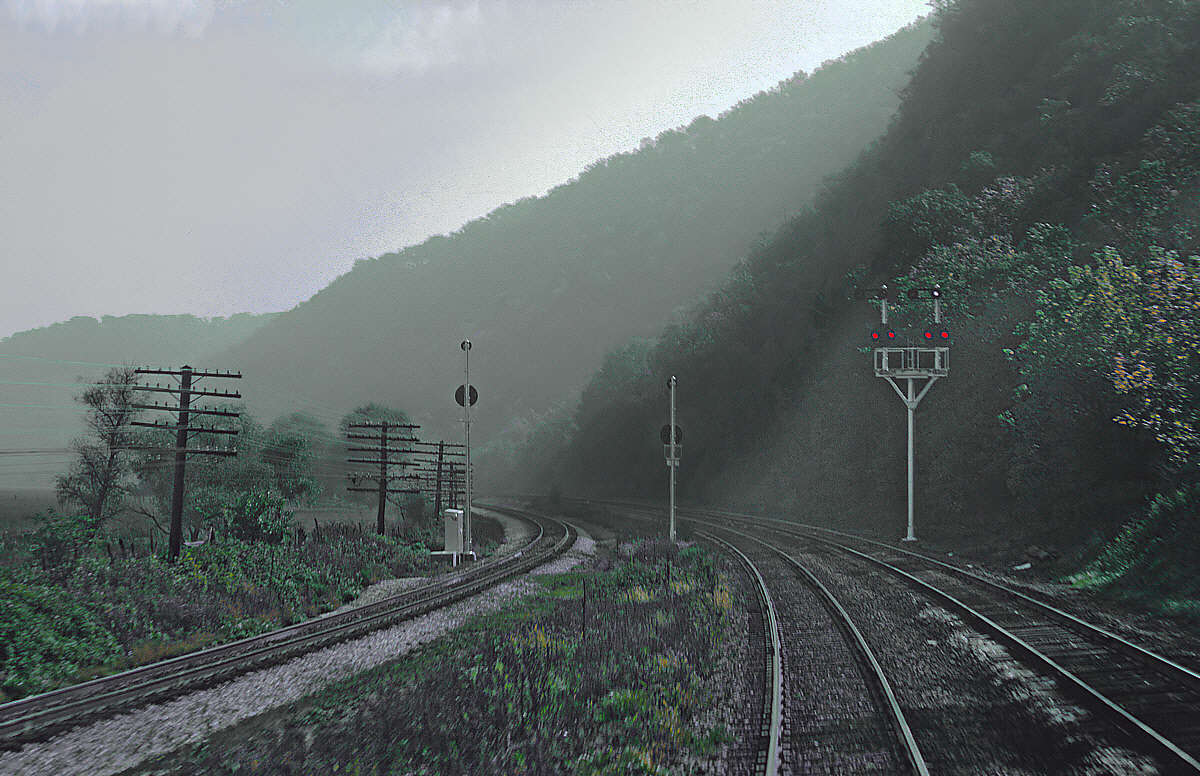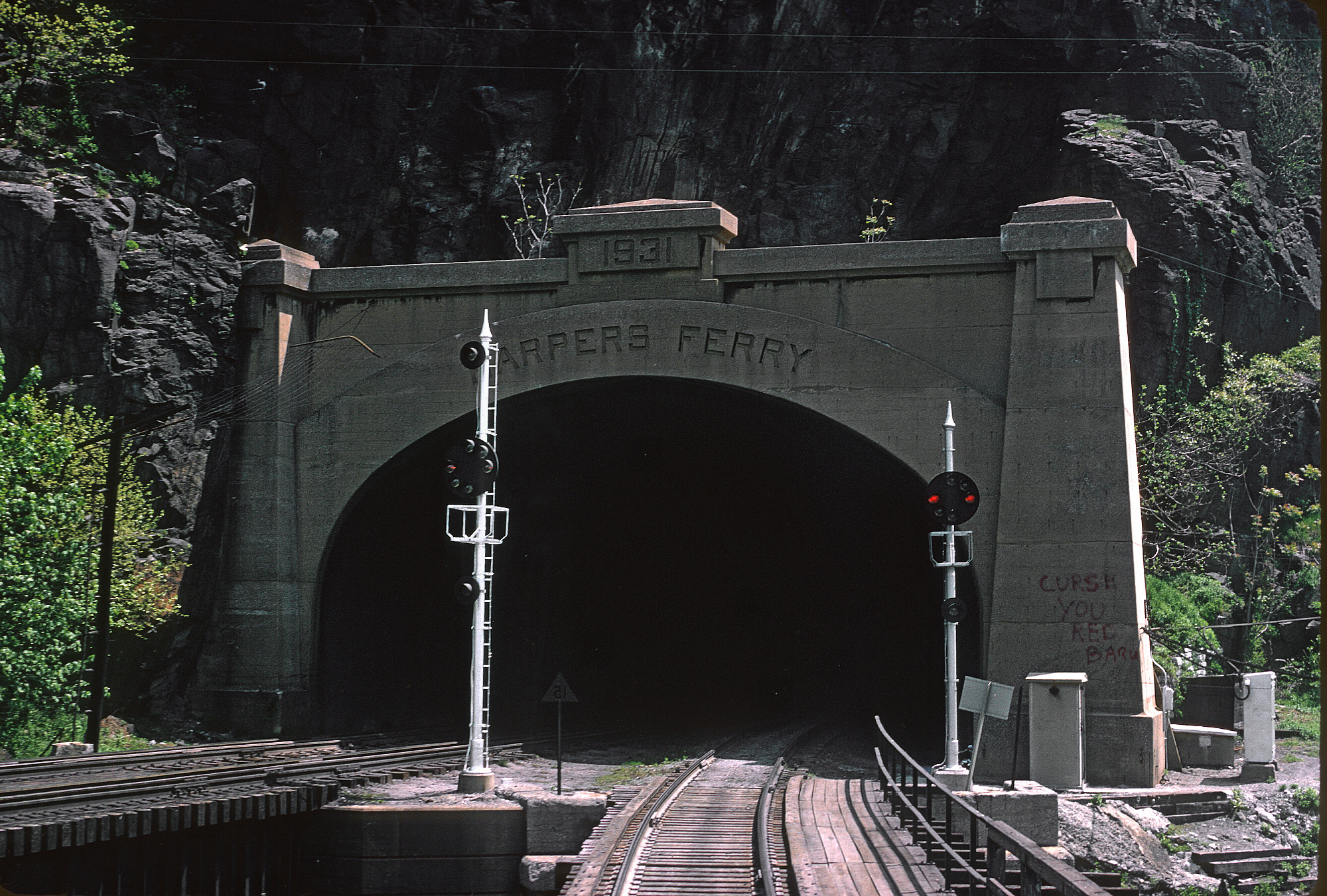B&O CPL Signals: Function, History, Photos
Last revised: March 1, 2025
By: Adam Burns
The Baltimore and Ohio's Color Position Light (CPL) signals represent a fascinating chapter in railroad signaling history. These distinct signals not only embodied advanced engineering concepts but also became iconic symbols of the B&O itself.
Many railroaders have stated the CPLs were the easiest to grasp and most redundant of all the classic signaling systems as they were relatively simple to understand.
Alas, successor CSX Transportation has largely replaced all of the classic CPLs with the modern, LED "Darth Vader" system. This article briefly delves into the history, functionality, and legacy of the CPL signals.
 A classic Baltimore & Ohio CPL protects the interlocking at Point of Rocks, Maryland on May 3, 1969. Roger Puta photo.
A classic Baltimore & Ohio CPL protects the interlocking at Point of Rocks, Maryland on May 3, 1969. Roger Puta photo.B&O History
Before exploring the intricacies of the CPL signals, it's essential to understand the backdrop—the Baltimore and Ohio Railroad. Chartered in 1827, the B&O holds the distinction of being the first common carrier railroad in the United States.
With a pioneering spirit, the railroad was renowned for numerous firsts in the industry, including the first passenger train to travel at speeds over 15 miles per hour.
By the early 20th century, the B&O Railroad was a significant player in the American railway system, covering a vast network that transported both passenger and freight traffic. As the railroad expanded, the need for an efficient and reliable signaling system became paramount, leading to the introduction of the CPL signals.
Evolution of Signaling
Railroad signaling is crucial for ensuring the safe and efficient movement of trains. Early signaling methods included manual semaphore signals and electric signals with simple red, yellow, and green lights. While functional, these systems possessed limitations, particularly in terms of visibility and reliability, especially under diverse weather conditions.
The quest for a superior signaling system gave rise to the Color Position Light signals, which were designed to address many of these issues. Developed in the 1920s and later perfected, CPL signals became a hallmark of the Baltimore and Ohio Railroad's commitment to safety and technological advancement.
Design and Functionality
CPL signals were revolutionary in their design. What set them apart was the combination of position and color to convey instructions to train engineers. This dual method of communication ensured that even if one aspect (color or position) was compromised, the other could still convey accurate information.
Components of CPLs
1. **Target Head and Marker Lights**: The CPL system comprised a circular target head with a series of lights arranged both radially and centrally. The signals also featured additional marker lights.
2. **Light Colors and Positions**: The primary lights on the target head could display red, yellow, or green signals. The position of these lights (top, bottom, left, right) further determined the signal's meaning. The lights were not simply static; they were positioned in various configurations to communicate specific instructions:
- **Horizontal Red Lights**: Indicated a complete stop.
- **Vertical Green Lights**: Signified clear or proceed.
- **Diagonal Yellow Lights**: Warned of caution or approach signaling.
3. **Marker Lights**: These lights were smaller and additional beyond the main target head. They provided supplementary instructions and added layers of safety. White lights, for example, could be used in combination with other configurations to modify the primary signal.
 Roger Puta photographed Color Position Lights protecting the main line near Cumberland, Maryland on October 4, 1969.
Roger Puta photographed Color Position Lights protecting the main line near Cumberland, Maryland on October 4, 1969.Understanding CPL Signal Aspects
CPL signals communicated a range of different aspects to train engineers, ranging from the most restrictive (stop) to highly permissive (clear). Some of the more critical aspects included:
1. **Stop Signal**
- Displayed by horizontal red lights, instructing the engineer to halt the train.
2. **Clear Signal**
- Displayed by vertical green lights, indicating that the track ahead was clear, and the train could proceed at the maximum authorized speed.
3. **Approach Signal**
- Often displayed by diagonal yellow lights, warning engineers to proceed with caution and be prepared to stop at the next signal.
4. **Restricted Signals**
- These indicated specific speed restrictions or conditions, often shown using combinations of marker lights and the primary light positions.
The beauty of the CPL system was its redundancy; even if an engineer could not distinguish the color of the lights due to weather or other conditions, the light's position still conveyed critical information.
Technological Advancements
As time progressed, technological enhancements further refined CPL signals. Innovations in electric circuitry allowed for more reliable and precise control of the lights. Additionally, maintenance and operational protocols were continuously refined to ensure these signals remained operational under various conditions.
Decline and Legacy
From their inception through the mid-20th century, the B&O's CPL signals were at the forefront of railroad safety. However, as railroads modernized and merged, new signaling technologies began to replace older systems, including CPL signals.
Despite their eventual phasing out, CPL signals left an indelible mark on railway signaling. They represented a bridge between early signaling methods and modern advancements, illustrating a period when railroads placed paramount importance on safety and innovation.
 Single-mast CPLs protect the B&O main line near Harpers Ferry, West Virginia on May 3, 1969. Roger Puta photo.
Single-mast CPLs protect the B&O main line near Harpers Ferry, West Virginia on May 3, 1969. Roger Puta photo.Conclusion
The B&O's Color Position Light signals are more than just relics of the past; they symbolize a legacy of ingenuity and progress in the realm of rail transportation.
Understanding their history and functionality enriches our appreciation of how far railroad signaling has come and underscores the ongoing quest for safety and efficiency in train operations.
Alas, most of the railroad's classic signals have since been replaced by successor CSX Transportation as the Class 1 has spent the last few decades updating its network with modern solid-state color light signals.
Train enthusiasts often refer to these new designs as "Darth Vader" types due to their protracted hoods to ensure the aspect is clearly visible in either daytime or nighttime settings. The signals appear almost like a traffic light and harken back to older systems like the Chesapeake & Ohio's color lights.
As rail enthusiasts and historians continue to preserve and study these systems, the legacy of the B&O's CPLs will undoubtedly remain an enduring testament to a transformative era in railway history.
Recent Articles
-
Oregon Railroad Museums: A Complete Guide
Apr 25, 25 03:11 PM
With its rich tapestry of scenic landscapes and profound historical significance, Oregon possesses several railroad museums that offer insights into the state’s transportation heritage. -
North Carolina Railroad Museums: A Complete Guide
Apr 25, 25 02:56 PM
Today, several museums in North Caorlina preserve its illustrious past, offering visitors a glimpse into the world of railroads with artifacts, model trains, and historic locomotives. -
New Jersey Railroad Museums: A Complete Guide
Apr 25, 25 11:48 AM
New Jersey offers a fascinating glimpse into its railroad legacy through its well-preserved museums found throughout the state.

